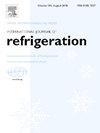FEMCE – A 3D finite element simulation tool for magnetic refrigerants
IF 3.5
2区 工程技术
Q1 ENGINEERING, MECHANICAL
International Journal of Refrigeration-revue Internationale Du Froid
Pub Date : 2025-02-16
DOI:10.1016/j.ijrefrig.2025.02.017
引用次数: 0
Abstract
A critical challenge for magnetic refrigeration is designing shape-optimized refrigerants. When applying a magnetic field to the refrigerant, its magnetocaloric effect (MCE) heterogeneity is directly related to the demagnetizing field (a geometric phenomenon). Striking a balance between the total mass/volume of refrigerant, and its effective performance at a given temperature and applied magnetic field is a complex non-linear magnetostatics problem. We present a tool for estimating both the spatially-resolved and effective MCE for any refrigerant design, via the 3D finite element method - Finite Element Magnetocaloric Effect (FEMCE). FEMCE allows the user to input complex refrigerant shapes, together with the thermophysical properties of the material, to estimate and optimize its refrigerant performance for a given temperature and applied magnetic field change. The tool can be readily employed for both the conventional and demagnetizing-field induced MCE.
FEMCE -磁性制冷剂的三维有限元模拟工具
磁制冷的一个关键挑战是设计形状优化的制冷剂。当对制冷剂施加磁场时,制冷剂的磁热效应(MCE)非均质性与退磁场(一种几何现象)直接相关。如何平衡制冷剂的总质量/体积及其在给定温度和外加磁场下的有效性能,是一个复杂的非线性静磁问题。我们提出了一种工具,用于估算任何制冷剂设计的空间分辨和有效MCE,通过三维有限元方法-有限元磁热效应(FEMCE)。FEMCE允许用户输入复杂的制冷剂形状,连同材料的热物理性质,以估计和优化其制冷剂性能在给定的温度和外加磁场变化。该工具可以很容易地用于传统和退磁磁场诱导的MCE。
本文章由计算机程序翻译,如有差异,请以英文原文为准。
求助全文
约1分钟内获得全文
求助全文
来源期刊
CiteScore
7.30
自引率
12.80%
发文量
363
审稿时长
3.7 months
期刊介绍:
The International Journal of Refrigeration is published for the International Institute of Refrigeration (IIR) by Elsevier. It is essential reading for all those wishing to keep abreast of research and industrial news in refrigeration, air conditioning and associated fields. This is particularly important in these times of rapid introduction of alternative refrigerants and the emergence of new technology. The journal has published special issues on alternative refrigerants and novel topics in the field of boiling, condensation, heat pumps, food refrigeration, carbon dioxide, ammonia, hydrocarbons, magnetic refrigeration at room temperature, sorptive cooling, phase change materials and slurries, ejector technology, compressors, and solar cooling.
As well as original research papers the International Journal of Refrigeration also includes review articles, papers presented at IIR conferences, short reports and letters describing preliminary results and experimental details, and letters to the Editor on recent areas of discussion and controversy. Other features include forthcoming events, conference reports and book reviews.
Papers are published in either English or French with the IIR news section in both languages.

 求助内容:
求助内容: 应助结果提醒方式:
应助结果提醒方式:


